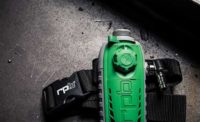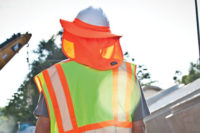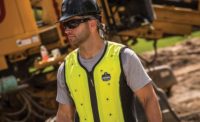Weather patterns are changing. The planet’s getting warmer. In fact, all but two of the hottest years on record have occurred since 2000. On average, excessive heat causes 650 deaths in the United States every year. Thirty-nine of those took place on the job in 2016 – double the amount that occurred only two years prior.
Know the risk
Heat stress occurs when the body’s means of controlling its internal temperature starts to fail. Once the body’s temperature reaches 99.7° F (37.6° C), heat stress has begun to affect the body. At 104° F (40° C), it becomes susceptible to severe damage. As little as 30 minutes of 104° temps can cause cellular damage to the brain or even death.
Two factors contribute to how heat stress affects the body: personal and environmental. Some workers are at greater risk before they ever step foot in the heat due to personal factors: being older or overweight, having heart disease or high blood pressure, or taking medications that do not react well to extreme heat.
The second contributing factor is environmental: high temperatures, direct sunlight, humidity, limited air movement, hot equipment, reflected heat from ground, water or objects, and clothing/PPE choices chief among them
Exposure to heat can lead to any number of illnesses. Heat rash, heat cramps, heat exhaustion and heat stroke are the four most common heat-related illnesses.
Heat rash
- How it happens: Occurs when sweat ducts become clogged and sweat can’t get to the surface of the skin
- Symptoms: Red blister-like eruptions, bumps and an itching sensation
- How to treat it: Keep the skin dry and rest in a cool place
Heat cramps
- How it happens: Salt and moisture levels are depleted through perspiration
- Symptoms: Painful spasms usually in the legs or abdomen
- How to treat it: Move to a cool, shaded area, apply something cool, drink plenty of fluids
Heat exhaustion
- How it happens: Prolonged exposure to high temps and inadequate hydration causing body temps to rise
- Symptoms: Headaches, weakness, mood change, feeling sick, pale and/or clammy skin
- How to treat it: Move to a cool, shaded area, apply something cool, drink plenty of fluids and monitor.
Heat stroke
- How it happens: When the body becomes unable to control its core body temp
- Symptoms: Pale skin, nausea, vomiting, confusion
- How to treat it: Seek medical attention immediately
You can’t change the weather. But you can change your approach to working in the heat. Here are a few preventative measures to keep in mind.
Shelter + Shade
Smart solutions: Portable work shelter or umbrella combined with a misting system
When work must be done in the heat of the day, taking regular breaks and meals under the cover of shelters such as canopies, umbrellas and other temporary structures is important. So important, in fact, that states like Washington and California have regulations that require it.
Providing effective jobsite shade may require planning. Shelters should block direct sunlight with a purpose to provide a recovery area with access to fluids. Consider using areas with the natural shade of heavy tree cover or an awning or other temporary structure at the site. Take advantage of extra items like portable misting systems.
Hydration
Smart solutions: Hydration packs encourage more fluid intake than bottles, and ensure workers are never without cool, clean water
It’s easier than you think to get dehydrated. Heat-related illnesses are closely associated with a worker’s hydration level. Since heat stress is a widely recognized hazard, states including California and Washington have established specific workplace drinking water requirements as a major part of heat stress workplace controls. OSHA standards for both general industry and construction activities, as well as various safety guidelines, mandate that adequate drinking water is available to workers at all workplaces and jobsites.
Dehydration risks are more commonly recognized for work performed outdoors in warm temperatures or for work in hot indoor environments like foundries, bakeries, boiler rooms, kilns, etc. But they also exist for those toiling away in indoor jobsites with poor airflow or workers who wear special, protective clothing – such as non-permeable HAZMAT suits – as they face additional challenges.
Keeping clean, cool and convenient water accessible to workers can prove to be more challenging than one would think. Because hydration packs make water so readily available and hands-free simple, workers can hydrate without having to take a break from the task at hand. Hydration before, during and after shifts is key.
Cooling PPE
Smart solutions: Evaporative cooling towels, headbands, vests and more combine water and airflow and help keep the body’s core temperature regulated.
Evaporative cooling is a simple, effective, and relatively inexpensive approach that can be used in outdoor and indoor environments, but works best in drier, low-to-moderately humid conditions with sufficient airflow. Working on the same principles as how sweat cools the body, evaporative cooling solutions draw heat from workers’ bodies, using an external source of water.
Plan ahead
Heat-related illnesses and fatalities are 100-percent preventable when you know the risks, symptoms and solutions.
In extreme heat, combining the solutions outlined above with smart shift scheduling to move the most intense manual labor away from the hottest part of the day can have a measurable effect in mitigating the effects of heat.



